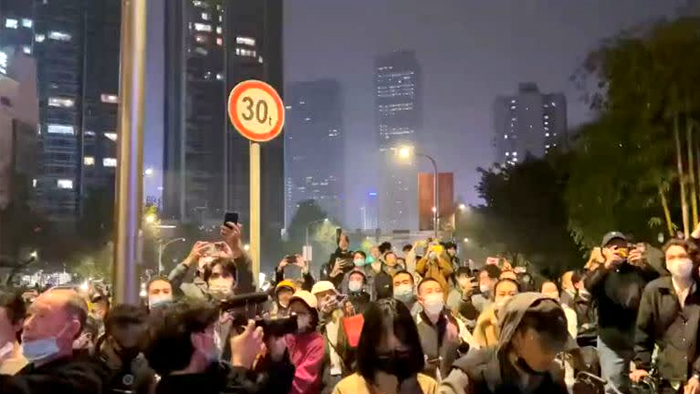COVID protests are getting worse in Guangzhou as anger over China’s lockdown grows.

People in Guangzhou, China, fought with riot police in white hazmat suits on Tuesday night, according to videos posted online. This was the latest in a series of protests that got worse over the weekend because of strict COVID-19 lockdowns.
The fights broke out after protests in Shanghai, Beijing, and other cities. China is seeing a record number of COVID cases every day, and health officials, including those in the southern area around Guangzhou, have said that some restrictions will be loosened.
Mainland The biggest wave of civil disobedience in China since the Tiananmen Square protests in 1989 is happening now, when the economy is slowing down after years of rapid growth.
Related: Asian stocks go up despite uncertainty in China, and people wait for Powell’s speech.
That time of prosperity was a key part of the agreement between the Communist Party and the people, whose freedoms have been greatly limited since President Xi Jinping took office 10 years ago.
In one Twitter video, dozens of riot police dressed in all-white pandemic gear and holding shields over their heads moved in a line over what looked like torn-down lockdown barriers as things flew at them.
Later, police were seen taking a line of people who were in handcuffs to an unknown place.
People were seen throwing things at the police in another video clip, and a tear gas canister landed in the middle of a small crowd on a narrow street, sending people running away from the fumes.
Reuters was able to confirm that the videos were shot in Guangzhou’s Haizhu district, where COVID-related unrest happened two weeks ago. However, they were unable to find out when the clips were taken, in what order the events happened, or what caused the fights.
People said on social media that the fights happened on Tuesday night and were caused by a disagreement about lockdown curbs.
The government of Guangzhou, which has been hit hard by the latest wave of infections, did not respond right away when asked for a comment.
The China Dissent Monitor, which is run by Freedom House and paid for by the U.S. government, said that at least 27 protests took place in China from Saturday to Monday. Australia’s ASPI thinks tank estimated that there would be 43 protests in 22 cities.
EASING CURBS
Guangzhou is a large port city in the province of Guangdong, north of Hong Kong. It is home to many migrant factory workers. Officials announced on Tuesday night that close contacts of COVID cases would be able to quarantine at home rather than being forced to go to shelters.
China has a policy called “zero COVID,” which says that no COVID should be allowed.
In Zhengzhou, where there is a big Foxconn factory that makes Apple (NASDAQ: AAPL) iPhones and where workers have been upset over COVID, officials have said that businesses, such as supermarkets, gyms, and restaurants, can open again in an “orderly” way.
But they also put out a long list of all the buildings that would stay locked down.
National health officials said on Tuesday, hours before these announcements, that China would respond to “urgent concerns” from the public and that COVID rules should be put in place with more flexibility, based on the needs of each region.
Related: According to one study, China is responsible for nearly 20% of Sri Lanka’s public debt.
But even though it seems like the government is trying to make people happy by relaxing some rules, they have also started looking for people who have been to recent protests.
“Police came to my door and asked me about it all and made me write it all down,” a Beijing resident who did not want to be named told Reuters on Wednesday.
Another resident said that some friends who posted videos of protests on social media were taken to a police station and asked to sign a promise that they “would not do that again.”
It wasn’t clear how the police found the people they wanted to talk to or how many of those people they talked to.
The Public Security Bureau in Beijing did not say anything.
On Wednesday, there were a lot of police cars and security guards at a bridge in eastern Beijing where a protest had happened three days before.
‘HOSTILE FORCES’
In a late Tuesday statement that didn’t mention the protests, the Communist Party’s top body in charge of law enforcement said that China would crack down hard on “hostile forces’ activities of infiltration and sabotage.”
The Central Political and Legal Affairs Commission also said that “illegal and criminal acts that disrupt social order” would not be allowed.
The Ministry of Foreign Affairs has said that rights and freedoms must be used within the law.
John Kirby, a spokesman for national security at the White House, said on Tuesday that protesters in China shouldn’t be hurt.
COVID has spread even though China has mostly cut itself off from the rest of the world and asked hundreds of millions of people to make big sacrifices to comply with constant testing and long-term isolation.
Even though the number of infections and deaths is low compared to the rest of the world, analysts say that reopening before increasing vaccination rates could cause a lot of illness and deaths and put a lot of pressure on hospitals.
The lockdowns have done a lot of damage to the economy. They have messed up global supply chains and shook up the financial markets.
China’s manufacturing and service activity in November was the lowest since April, when Shanghai was locked down for two months. This was shown by the data released on Wednesday.
Chinese stocks stayed the same, as markets weighed the country’s weak economy against the hope that public pressure could force China to reopen.
Kristalina Georgieva, who is in charge of the International Monetary Fund, said that China’s growth forecasts might be cut.





